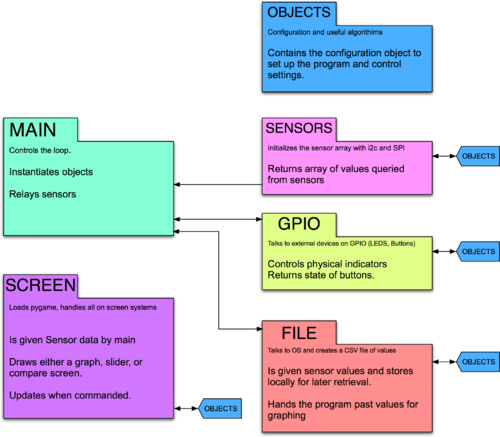PicorderOS
PicorderOS is a Python based set of modules that provides a quick and easy way to use a Raspberry Pi as a handheld sensing device. The real goal of PicorderOS is not just to operate my various Picorder projects as a monolithic entity but to work as a set of modules that the user can enable and disable at will.
By design it will support a wide range of arbitrary selected sensors, displays and form factors. Development is proceeding simultaneously on all elements.
Contents
Variants
The TR-108 uses a sensehat module and pygame to draw elements to screen.
The TR-109 comes in two flavours (BW and Color) and uses several sensors all brought together under one module. It is the most complex variant of the picorder.
Basic Structure
Objects
The Objects module contains some basic functions that are shared by many elements of the program. Most importantly it contains the "configuration" object that holds settings for the program. The user can edit this file to change settings quickly.
Main
PicorderOS's basic functional structure starts with the Main module. Main creates and directs all the elements necessary for a picorder session and directs the flow of information to and from each element.
Sensor
The sensor object is different depending on the physical sensors present. While the means of pulling sensor data may be different between different sensor types the purpose of the sensor object is to pull each value from the sensor and prepare it into a *sensor fragment*. Sensor fragments are lists (sort of like arrays) that contain the most recent sensor value and information for the program to put that value in context like the upper and lower possible ranges of the senor, the unit, symbol, and the name of the item itself. Many parts of the program will need to access this information so it is important for these elements to be available. Any sensor data can be accessed by PicorderOS so long as it follows these standards.
Notes
To reduce power consumption:
- Only draw to screen when sensor reading has changed.
scale would be a factor for determining; different decimal places would trigger different refresh rates.
Download
https://github.com/directive0/picorder2
Installation
PicorderOS requires quite a few python libraries to work.
Open a terminal and follow the next instructions:
- We must first enable SPI and I2C for sensor and display communications.
- Open Raspi Config
sudo raspi-config - Select "Interfacing Options" (Item 5)
- Scroll down to SPI and when prompted enable it following the onscreen dialogue
- Do the same for I2C
- Open Raspi Config
- Ensure you have Python3 and Pip3 installed (should already be there on Raspbian)
sudo apt-get install python3-pip python3-dev - Install Sensor Libraries
- If using the BME680 I recommend the Pimoroni bme680 module, install it using pip3
sudo pip3 install bme680
- If using the BME680 I recommend the Pimoroni bme680 module, install it using pip3
- Install luma.lcd for the displays
sudo pip3 install luma.lcd



